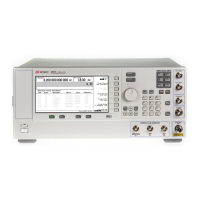E8257D/67D, E8663D PSG Signal Generators Service Guide
Troubleshooting
RF Path Description (Frequency Generation, Level Control, and Modulation)
1-103
ALC Loop
The ALC loop maintains power level control and power level accuracy. Level accuracy is achieved by converting a
portion of the RF signal to a dc voltage, comparing the measured dc voltage to a reference dc voltage, integrating the
difference, and using the integrated output to drive the ALC modulation diode. Level control is achieved by adjusting
the reference voltage.
The A23 Lowband Coupler/Detector, A24 Highband Coupler and A25 Highband Detector couple off the RF signal and
convert it to a dc voltage. Because the coupled signal is a known ratio of the RF output power, it can be used to
control the RF output level. On the A10 ALC assembly, the dc is compared to a reference voltage and integrated. The
integrated voltage is used to drive the modulator diodes on the A8 Output, A30 Modulation Filter, A36 Quadraplier,
and A37 44 GHz Upconverter. Temperature–sensing circuits maintain level correction over the specified temperature
range. In sweep mode, additional compensation is applied to the ALC from the A9 YIG Driver to maintain power
flatness during sweep.
A10 ALC
The A10 ALC assembly provides circuitry for level control and amplitude modulation. In ALC On mode (closed–loop
operation), the output signal level is continually monitored and used to adjust the modulator diode output to produce
the desired RF output level. In ALC On mode, the A10 ALC integrates the difference between the detected voltage and
the reference voltage to adjust the modulator diode drive until both voltages agree. The A23 Lowband
Coupler/Detector, A24 Highband Coupler, and A25 Highband Detector provide the feedback (detected DC) voltage to
the A10 ALC. On the A10 ALC, the reference voltage is generated by DACs that are controlled by the CPU. The DAC’s
output voltage is calibrated to the RF output power level.
In ALC Off mode (open–loop operation), the feedback path (the RF detected voltage path) is opened, and only the
reference voltage is used to set the output power level. With the modulator reference level set to a fixed drive level,
and without the output level being monitored, the RF output level can vary from the set power level. In open–loop
operation, the power level can also drift over time due to changes in temperature.
In external leveling operation, the internal detectors are replaced with an external detector, so the level control
voltage is provided by the external detector. The external detector must be a negative detector to provide the correct
polarity for the A10 ALC. In standard instruments, the external leveling operating range is option–dependent, but is
either –20 dBm or –15 dBm to maximum power.
Level accuracy is a function of the detector and instrument calibration. Because the instrument is calibrated with
internal detectors, external level accuracy depends on the difference in characteristics between the internal and
external detectors.
When internally leveled, the ALC circuit is temperature compensated to improve level accuracy over the specified
temperature range. Temperature compensation for the A25 Highband Detector consists of a temperature sensing circuit
on the A24 Highband Coupler. A resistor pack calibrates the A25 Highband Detector; if the A25 Highband Detector is
replaced, a new resistor pack is provided with the new detector, and must be installed on the A24 Highband Coupler.
Although rare, unstable level performance above 2 GHz can result from poorly soldered resistors on the resistor pack,
or with other components in the temperature compensation circuit.
The A23 Lowband Coupler Detector temperature correction circuit is inside the A23 Lowband Coupler Detector
package. Because the lowband detector and coupler are in one package, they cannot be replaced independently.
Modulation (Option UNT–AM, FM, ΦM, UNU–Standard Pulse, and UNW–Fast Pulse)
Modulation features apply only to certain options of signal generators. The A11 Pulse/Analog Modulation Generator
provides modulation signals for AM, FM, pulse, and phase, and SYNC OUT and VIDEO OUT. For phase synchronization
and modulation accuracy, a dual function generator on the A11 Pulse/Analog Modulation Generator is tied to the
10 MHz reference from A7 Reference. Pulse Input, EXT1, and EXT2 provide external modulation input connections. A
front panel low frequency output connector (LF Output) can be selected to output the signal generated by the
A11 Pulse/Analog Modulation Generator and can be used to drive other instruments.
EXT 1 and EXT 2 inputs contain modulation drive level detection circuits that generate error messages if the signal
applied to the input is too small or too large. The input impedance of EXT 1 and EXT 2 can be set for 50 or
600 ohms, and can be configured for dc or ac coupling.
AM (Option UNT)
The AM signal from the A11 Pulse/Analog Modulation Generator is routed to the A10 ALC, where it is summed with
the ALC reference voltage where it is used to drive the A30 Modulation Filter, A36 Quadraplier, A37 44 GHz
Upconverter, and A8 Output ALC diodes.

